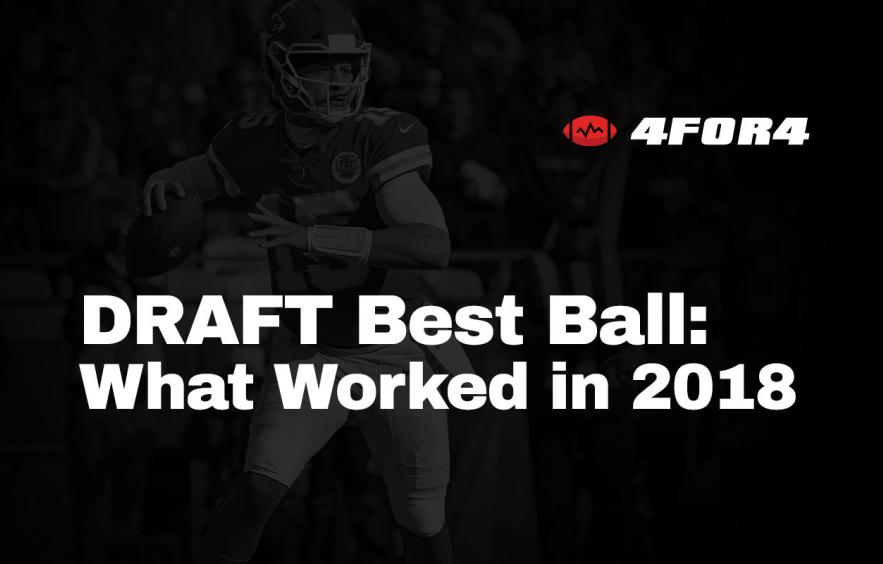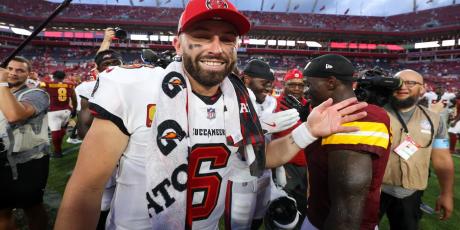What Worked in DRAFT Best-Ball Leagues for 2018

Best ball drafts are a testament to our knowledge of the game. We can’t just look at teams or projections in their perfect form. The season is long and full of terrors. Injuries, trades, and coaching changes tilt the table every season. Players who stand to gain have the late-season, league-winning upside that we hunt for every season. That makes draft strategy a mix of art and science. Research and a bit of luck. But while we can’t provide the luck, the research is readily available.
More DRAFT strategy articles: Managing Bankroll | Player Portfolio Builds
Best-ball drafts are not just about who is drafted, but when. Previous year roster construction win rates give us structure for the following year. It’s not exact, but it sets limits and gives us a general process. Taking DRAFT’s 2018 data, we’ll look at what worked and why. The half-point PPR typically highlights players that accumulate yardage (i.e. running backs), but the data shows that wasn’t always the case.
Overall Win Rates
Every season the community opines on their ideal draft slot. Early, middle, or late there’s a case that can be made for any position. But does it affect your chances of winning? Early picks have produced high win rates in the past and guarantee elite talent in the first round. Middle picks are a safeguard against positional runs. The only area that poses the most risk is the late-phase of the first round.
| Win Rate | ||
|---|---|---|
| Slot | 2017 MFL | 2018 DRAFT |
| 1 | 4.7 | 13.9 |
| 2 | 15.7 | 5.8 |
| 3 | 13.7 | 6.6 |
| 4 | 11.3 | 7.6 |
| 5 | 7.7 | 10.4 |
| 6 | 7.6 | 11.4 |
| 7 | 8 | 11.2 |
| 8 | 7 | 8.8 |
| 9 | 6.3 | 7.2 |
| 10 | 7.1 | 6.2 |
| 11 | 5.9 | 5.8 |
| 12 | 4.7 | 5.1 |
If all picks were created equal, then the average win rate should be 1 in 12 or 8.3%. It’s a small sample size, but it’s striking that picks 9-12 didn’t hit that rate across either platform. This is somewhat intuitive given yearly ADP trends. The top typically remains in place while middle and late picks fluctuate. It forces us to take a hard look at our draft strategy as it pertains to roster construction while we build our teams.
Roster construction is the science behind the art, the number of players at each position drafted that resulted in a win. It doesn’t show when the players were drafted, but give us a general structure to compare with associated rates of success.
| Roster | Win% |
|---|---|
| 3 QB 6 RB 7 WR 2 TE | 9.21 |
| 2 QB 6 RB 8 WR 2 TE | 8.96 |
| 2 QB 7 RB 7 WR 2 TE | 8.88 |
| 3 QB 5 RB 8 WR 2 TE | 8.74 |
| 2 QB 6 RB 7 WR 3 TE | 8.64 |
| 2 QB 5 RB 8 WR 3 TE | 8.44 |
| 3 QB 6 RB 6 WR 3 TE | 8.36 |
| 3 QB 5 RB 7 WR 3 TE | 7.91 |
There are two key takeaways here. First, the high prevalence of 3-QB builds. DRAFT, like most best-ball platforms, only requires one starting QB per week. The optimal approach to this onesie position revolves around only using two roster spots on the position. It allows for draft capital to be spent at other positions of need. Second, we look at the number of running backs selected. At best, the total number of running backs were either equal to or less than the number of receivers drafted. Never greater. Even with half-point PPR scoring, receivers maintain priority with the bonus. This deserves a closer look into how these approaches were profitable in 2018.
Quarterbacks
Only requiring a single quarterback drives most managers to only drafting two to conserve draft capital. There are two viable strategies to apply this concept.
- 1 Early, 1 Late – Sacrifice opportunity cost for a Tier 1 quarterback at their ADP (7th round or earlier). Complement their elite production with a late-round option as a bye-week filler.
- 2 Middle – Construct an optimal roster early and take two quarterbacks during the middle rounds (8-12).
Strategy #1 carries the most risk due to the supply and demand nature of the position. Only one quarterback is needed, but multiple running backs and wide receivers are started each week. So, while a binary decision is easy (Aaron Rodgers or Derrick Henry, Deshaun Watson or Marvin Jones), considering your full roster is required to determine the impact of such an early acquisition. Despite the risk, it paid off.
Drafters selecting a QB in the fifth round had a 9.4% win rate in 2018. Based on ADP, Deshaun Watson (54.3) was the likely target who carried an 11.1% player win rate. His eight QB1 finishes were enough to justify the pick, but the downside is treacherous. Aaron Rodgers 2018 season should caution drafters from investing in the position early in drafts. The sixth and seventh rounds were similarly successful with win rates of 9.4% and 8.9%, respectively. However, quarterbacks at that ADP were Cam Newton (73.4) and Drew Brees (82.7). Each with their own warts heading into 2019 speaking to the volatility around the strategy.
A 3-QB strategy looks to maximize a roster’s potential everywhere else except quarterback. By waiting, solid pass catchers can be drafted with some semblance of QB cobbled together later. This typically occurs in the middle to later rounds with the objective being weekly upside. By ADP, the common options were:
| Player | Win Rate | ADP |
|---|---|---|
| Carson Wentz | 6.3 | 90.8 |
| Kirk Cousins | 8.1 | 98.8 |
| Andrew Luck | 8.6 | 101.2 |
| Jimmy Garoppolo | 4.7 | 102.6 |
| Matthew Stafford | 4.9 | 105.5 |
| Ben Roethlisberger | 11.3 | 109.7 |
| Philip Rivers | 8.0 | 115 |
| Matt Ryan | 12.1 | 118.3 |
| Patrick Mahomes | 21.3 | 120.9 |
| Jared Goff | 10.8 | 121.9 |
| Marcus Mariota | 6.4 | 125.9 |
| Alex Smith | 5.0 | 133.5 |
| Dak Prescott | 7.7 | 137.8 |
| Derek Carr | 7.4 | 142.7 |
The bevy of mid-round options provided a solid floor with minimal risk. But we need ceiling plays to win the league. Pat Mahomes was drafted in the 11th round producing the fourth-highest win rate across all positions at 9.8%. His 21.3% player win rate was third for all players and a significant component to the success of 3-QB builds. A Ben Roethlisberger/Patrick Mahomes/Mitchell Trubisky rotation is both within the realm of possibility and reduced the impact of opportunity cost. But with Mahomes’ immediate spike in value, we’ll have to identify the next best late-round target in 2019.
Running Backs and Wide Receivers
A minimum of two running backs and three wide receivers are started each week. Injuries or bad matchups increase the demand at these positions. With the supply being limited, draft resources must be properly allocated to ensure an optimal roster.
| Running Back | Wide Receiver | ||||
|---|---|---|---|---|---|
| Player | Win Rate | ADP | Player | Win Rate | ADP |
| Christian McCaffrey | 26.7 | 18.2 | Tyreek Hill | 17.9 | 30.1 |
| James Conner | 24.5 | 182.3 | Robert Woods | 15.9 | 82.5 |
| Todd Gurley | 17.2 | 1.3 | Davante Adams | 15.8 | 21.4 |
| James White | 16.5 | 123.5 | Calvin Ridley | 14 | 135.2 |
| Alvin Kamara | 15.4 | 5.8 | Adam Thielen | 13.1 | 31.3 |
| Tarik Cohen | 15.4 | 80.6 | Kenny Golladay | 12.8 | 127.7 |
| Saquon Barkley | 15.1 | 6.9 | Brandin Cooks | 11.5 | 46.3 |
| Nick Chubb | 14.5 | 108.8 | Tyler Lockett | 11.3 | 138.9 |
| Chris Carson | 12.9 | 106.9 | Chris Godwin | 11 | 162.8 |
| Austin Ekeler | 12.3 | 174.7 | Dede Westbrook | 11 | 168.1 |
A few were early-round picks, but notice the number of players with ADP values in the triple digits. Injuries and other shifts in volume highlight the need to take the long view during drafts. In doing so, fantasy production equal to an early-round player can be acquired at a lesser cost turning the tide in your favor. So, acquiring players at multiple stages of the draft leads to an optimal roster that will be competitive within your league.
Tight Ends
Tight end is another onesie position, but harder to assess compared to the quarterback. Drafting tight ends can be approached the same way as quarterbacks. However, their weekly usage can shift as they hold multiple roles on the field. That makes the proposition of using early draft capital on a tight end a bit difficult. That may have worked well in 2018, but there were multiple options available later.
| Player | Win Rate | ADP |
|---|---|---|
| Travis Kelce | 17.4 | 27.6 |
| George Kittle | 15.6 | 111 |
| Eric Ebron | 15.4 | 140.6 |
| Zach Ertz | 13.4 | 35.4 |
| Jared Cook | 12.9 | 158.2 |
| Austin Hooper | 10.8 | 163 |
| OJ Howard | 9.7 | 129 |
| David Njoku | 8.8 | 116.6 |
We've been spoiled by record-breaking tight end performances. However, the position isn't as voluminous as it was in years past. Tight end targets have been on a steady decline the past few seasons. The overall 9.4% drop in targets has been buoyed by elite efficiency. But with six of the eight highest-scoring tight ends coming in the ninth round or later, those picks are best spent at positions of need.
Looking to 2019
Just draft the right players, it's that easy. The only issue is that we don’t know who those players will be. Recency bias and the continued progression of offensive situations inflate the cost of our favorite players. Christian McCaffrey has gone from a mid-second pick to a top-four selection, and Calvin Ridley can no longer be found in the 11th round. But while the names have changed, the strategy hasn’t. This season will be filled with unforeseen twists and new faces emerging from the ranks of our favorite teams. So while we don’t have the flexibility of using waivers to supplement our rosters, our draft strategy has to accomplish this task to secure a win.






















